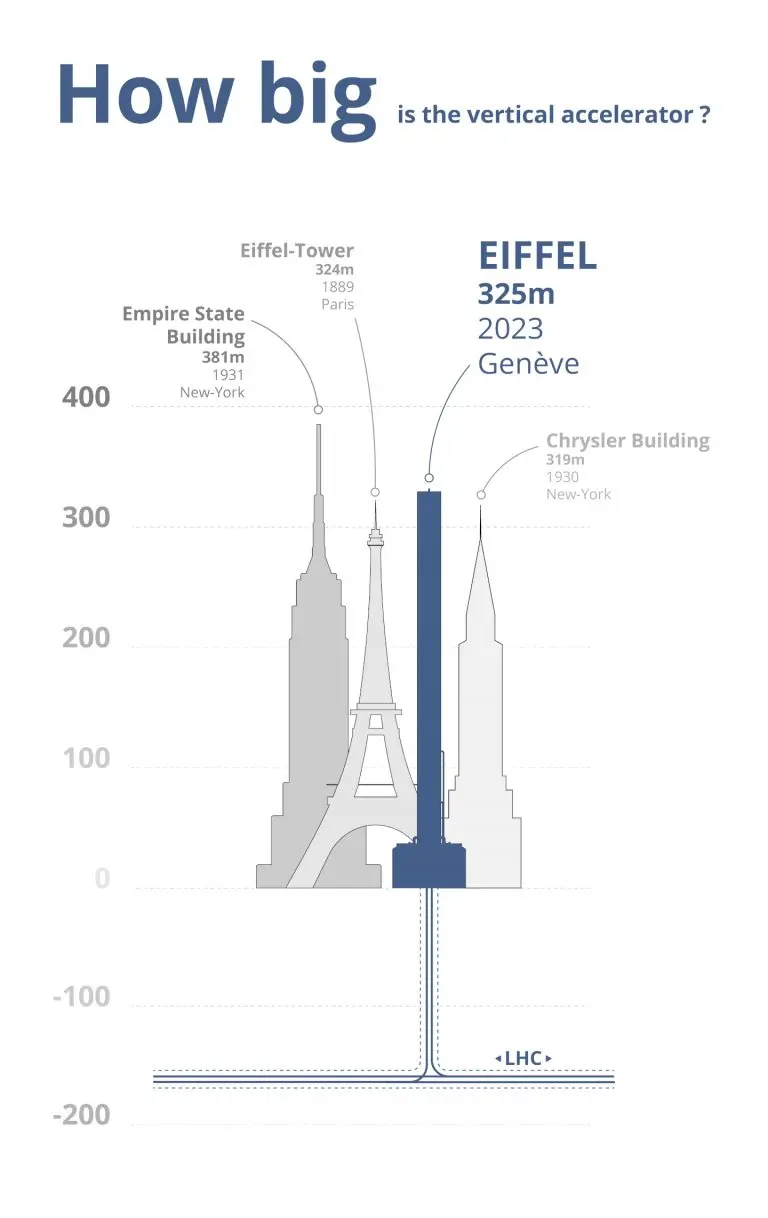CERN’s newly proposed EIFFEL space elevator accelerator is eventually going to be the tallest structure on Earth. 3dpbm can exclusively reveal that the 2.5 Km tall structure will be entirely 3D printed using both concrete and metals, which engineers now see as the only possible way to make it structurally sound.

The use of 3D printing at CERN has been ramping up lately, with several physics laboratories and experiments benefiting from AM capabilities to create highly intricate, unique structures needed run the particle detectors. Now, with inspiration from GE’s wind turbines, it’s time to usher in an entirely new level of large format additive manufacturing (LFAM) implementation. In fact, the proposed concept clearly shows the layer lines from material deposition.
The goals of the new accelerator project are very ambitious and intend to demonstrate the existence of antigravity affecting antimatter. In fact, scientists are now theorizing that–if their theories are demonstrated—the structure could even be built by depositing construction material from the top down.
“Do antimatter apples fall up?” is a question that is certain to aggravate physicists working on a new vertical accelerator proposed for CERN. The true question, they say, is whether antimatter apples fall down differently. If a difference were spotted, it would spell the end of “CPT invariance” – a principle that has underpinned every theory of physics since the invention of quantum mechanics.
“The Standard Model of particle physics has been very successful, but it can’t explain the 95% of the universe which is ‘dark’, and neither Einstein nor any physicist since has been able to cook up a working theory of quantum gravity,” says theorist Flora Oilp. “It’s time to challenge its most fundamental principle head-on.”
Manufacturing on Demand
The way forward, according to Oilp and her colleagues, is to build a vertical accelerator that will put gravity to the test directly. Every previous particle accelerator has been horizontal. A combination of high speeds and frequent course corrections using focusing magnets has always meant that the effect of gravity can be neglected. But by utilizing a range of new, revolutionary techniques, including accelerating particles upwards inside a vacuum vessel, and timing how long they take to fall back down to Earth, physicists can study the elusive fourth force directly. Furthermore, by comparing results with protons and antiprotons, they can watch for signs of “CPT violation”. Such behavior cannot be explained using conventional theories, which rely on this principle to ensure the conservation of probability.
The accelerator would be built in two stages. Stage one proposes a 500 m vertical accelerator, starting from the base of the LHC shafts. An exciting collaboration with NASA may come to fruition by utilizing detectors on the International Space Station (ISS) to detect beams of particles fired by the accelerator every time the ISS is overhead. This “reverse cosmic-ray” experiment would allow the measurement of Earth’s gravity on particle trajectories at unprecedented levels. Stage one will seek to match the roughly 1% precision on measurements of the gravitational constant “g”, which is currently being targeted in parallel by experiments with antihydrogen at the Laboratory’s Antimatter Factory. This moderate build will also allow engineers and physicists to understand the intricacies of running a vertical accelerator in preparation for stage two – the space elevator.
First proposed by Russian scientist Konstantin Tsiolkovsky in 1895, a true space elevator would rise from the equator to a height of 35 786 km – the altitude of a geostationary orbit. CERN’s proposed structure is far more modest, rising a mere 2.5 km above the Swiss countryside. If built, however, this advanced particle accelerator would nevertheless be three times taller than the Burj Khalifa in Dubai, which has been the tallest structure in the world since 2009. Each bunch of protons and antiprotons would need to be sent into a so-called “radial elliptic orbit” so that they return to the same point from which they were launched, calling for minute transverse focusing along the way.
Though the technological challenges are formidable, links to industrial and medical applications are promising, and the physics reach of such a machine is compelling. While appearing somewhat outlandish at first sight, the key advantage of the design is that its sensitivity would scale rapidly with its height. With the project eventually being ramped up to 2.5 km – the maximum height thought to be structurally sound, the CPT invariance could be tested with exquisite precision, approaching 0.005%.
“The sky’s the limit!” says CERN’s Pilar Olof, who was recently elected spokesperson of the new Elevator-Inspired Fast-Fermion Endwise Linac collaboration (EIFFEL). “Recent years have seen debates over whether the next accelerator should be linear or circular, but a consensus is now building that it should be vertical. We can’t wait for the world to see the EIFFEL.”
* This article is reprinted from 3D Printing Media Network. If you are involved in infringement, please contact us to delete it.
Author: Davide Sher


Leave A Comment